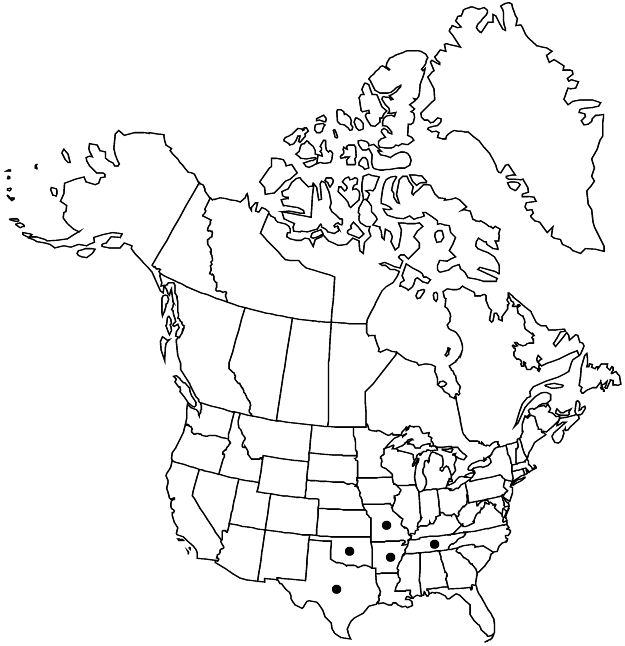Euphorbia ouachitana
J. Bot. Res. Inst. Texas 7: 642, figs. 2[row 2, right], 6. 2013.
Herbs, annual, with taproot. Stems erect-ascending, often basally decumbent, often branched near base, 12–28 cm, glabrous. Leaves: petiole 0–3 mm; blade broadly oblanceolate to subspatulate, or proximalmost often orbiculate, 3–20 × 3–9 mm, base attenuate, margins entire, apex rounded to emarginate, surfaces glabrous; venation pinnate, midvein prominent. Cyathial arrangement: terminal pleiochasial branches 3, 1–3 times 2-branched; pleiochasial bracts ovate-deltate to subrhombic-ovate, shorter and wider than distal leaves; dichasial bracts connate 1/4 length, not imbricate, broadly deltate to subreniform, base truncate to broadly obtuse, margins entire, apex obtuse to bluntly acuminate; axillary cymose branches 1–5. Cyathia: peduncle 0.4–0.7 mm. Involucre infundibular, 1.3–1.6 × 1–1.2 mm, glabrous; glands 4, crescent-shaped; 0.4–0.5 × 0.8–1 mm; horns divergent, 0.2–0.4 mm. Staminate flowers 15–20. Pistillate flowers: ovary glabrous; styles 0.8 mm, 2-fid. Capsules ovoid-globose, 2.6–2.7 × 2.5–2.7 mm, slightly lobed; cocci rounded to ± flattened, smooth, glabrous; columella 2–2.1 mm. Seeds dark brown, oblong-ovoid, 1.5–2 × 1–1.6 mm, with deep, rounded pits in 3–4 regular vertical rows; caruncle reniform-ovate, conic, 0.5–0.7 × 0.5–0.8 mm. 2n = 26.
Phenology: Flowering and fruiting spring.
Habitat: Semiopen forests, bluffs and ledges, stream banks, glades.
Elevation: 100–400 m.
Distribution

Ark., Mo., Okla., Tenn., Tex.
Discussion
Euphorbia ouachitana is restricted to semiopen forests and woodlands in the south-central United States. It is similar to E. commutata and has been most commonly identified as that species in the past. However, it differs in its consistently brown seeds that have pits in regular, vertical rows. The two species also differ in E. commutata’s numerous, proximal, long-petiolate elliptic leaves. The proximal leaves of E. ouachitana are spatulate with an orbiculate blade and petiolelike base. Aside from the restricted distribution of E. ouachitana in Missouri and Tennessee, the ranges of E. ouachitana and E. commutata do not overlap (see M. H. Mayfield 2013 for a detailed discussion of the distribution). Euphorbia ouachitana is most common in the Ouachita Mountains from southeastern Oklahoma to Hot Springs County, Arkansas.
Selected References
None.